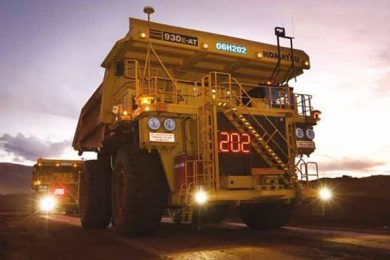Rio Tinto went into some detail on better asset utilisation in its recent investor seminar in Sydney on December 4th, which included a very interesting insight into its autonomous trucks strategy, which perhaps will mirror the strategy of all the big mining groups going forward. There are now 76 Komatsu 930E-AT 320 t trucks equipped with the Frontrunner Autonomous Haulage System in Rio’s 400-strong truck fleet in its Pilbara iron ore mines, which are an estimated 15% cheaper to run than the rest. These are located at Yandicoogina, Hope Downs 4, Nammuldi and Silvergrass.
But these were all added as new autonomous trucks, with the challenge now how to get the autonomy benefits out the rest of the existing fleet, which Rio is setting out to do via retrofits of Komatsu’s AHS system on the older trucks. It would also seem to be a much cheaper option than continuing to add brand new autonomous trucks, though no doubt this will continue where it makes sense; plus it is unclear if the technology allows for mixed fleets of “new AHS” and “retrofit AHS”.
Chris Salisbury, Chief Executive, Iron Ore stated: “Now that we have undertaken the first Komatsu AHS retrofit, we will increase the rate of retrofit; we will use more machine to machine control loops; and better predictive analytics to move maintenance from breakdown into the planned domain.”
He added in the Q&A: “In terms of the retrofit we are very clear: first of all, we want to make sure we are extracting value out of the capital we have already installed and I’ve talked a lot about some of the work we’ve done on payload and improving utilisation and so on, and we want to make sure we do extract that first. The second point I would make is we are going to proceed in an appropriate manner. We have done the first maxi retrofit, we wanted to make sure we understood that process, and we will move forward with a retrofit strategy, but again being really clear, it is not just about retrofitting to every truck we have it’s actually got to be on a value basis. The fleets are at different ages, they are used in different applications, we want to make sure it is focused on value, not just about fitting new toys.”
Finally, he states: “And we will achieve further improvements as we replicate best practice and extend our AHS fleet – both new and retrofit. We are now successfully operating the first Komatsu AHS truck retrofit in the world, and we will fine tune the retrofit process ahead of expanding to selected fleets, based on value.”
As stated, to date all the new Komatsu AHS trucks have been 930E models but in the Pilbara, Rio’s fleets include many 730E and 830E models such as at Marandoo and Brockman, so if these fleets are to go autonomous this will be new ground for Komatsu’s AHS technology, being not only retrofits but retrofits to new models. However, the learnings in retrofitting across different truck types will be very valuable as Rio Tinto looks to apply autonomy elsewhere in the world in other fleets, which of course it will.
It isn’t only autonomy that is changing the way Rio’s trucks are used. By the end of October 2017, through better truck utilisation using initiatives such as fitting better tyres and lighter trays to the 830E 240 t trucks, Rio has found an extra 20 t of ore or waste per load, meaning Rio it has managed to park around 40 trucks. “By way of example, this has enabled labour savings alone of more than US$13 million. And we will achieve further improvements as we replicate best practice and extend our AHS fleet – both new and retrofit.” So while the current status is 76 out of 400, in reality it could be seen as 76 out of a total of 360 or less. Also, having parked trucks around would seem to further negate the need for brand new autonomous trucks, with a lower cost retrofitting option available.
Of course retrofitting is not new in the industry. Autonomous Solutions Inc (ASI) has been applying its OEM agnostic autonomous truck retrofit solution to Anglo American’s truck fleets in South Africa and elsewhere as part of that company’s FutureSmart™ initiative. Caterpillar has developed autonomous mining truck technology for an expanded range of models, including its own range, but also other brands. In early 2017 at a Cat® MineStar™ Command for hauling demonstration at the company’s facility in Arizona, Caterpillar announced a project to adapt hardware and software for retrofitting the Komatsu 930E mining truck with Cat autonomous technology, stating: “This interoperability initiative is driven by mining companies’ goal of reducing mining costs using their existing fleets.” It seems Caterpillar knew this wave of retrofitting was on its way, though it has been successful in selling its new Cat 793F CMD autonomous trucks in the Canadian oil sands and in South America now, on top of FMG Solomon and BHP Jimblebar in Australia, bringing its AHS total to over 100 new machines. BHP having Caterpillar as a global strategic partner, is no doubt looking at the retrofit option at multiple sites.
So it seems that the big show in town now for the autonomous solution providers is retrofitting; whether the system is provided by Caterpillar, Komatsu, ASI or someone else, and whatever brand of truck the autonomy retrofit is being applied to. Arguably, it is a far larger immediate market for the technology than selling new autonomous machines. And things are moving fast in this market. Hitachi has just announced very successful tests of its AHS technology at Meandu, Liebherr is working with ASI on its autonomous truck solution, and BELAZ is rolling out autonomy through partner VIST Group at OCP in Morocco and soon with SUEK at a Russian coal mine.










